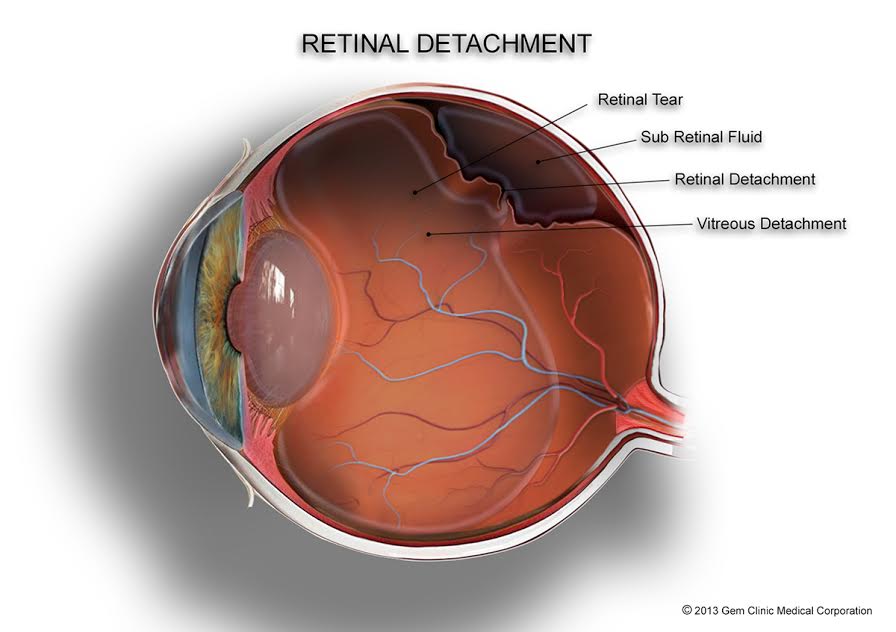


The macula is responsible for sharp central vision. The macula is the central portion of the retina that lies in the back part of the eye near the optic nerve, the cable that sends messages back to the brain. It acts like the film in a camera, capturing the "picture" that will be sent to the brain.
Hole in eye retina full#
Those who do a significant amount of strenuous work, will have a longer recuperative course then those who do not, but it rarely extends longer than 6 weeks, assuming there are not complications, even though the full recovery period for follow-up is 3 months.The retina is a Saran Wrap-thin membrane which is suctioned up against the inside back two-thirds of the eyeball. Return to work depends upon the type of work the patient performs. Topical eye meds are generally administered for 3 to 4 weeks post-surgery, and are tapered off by the fourth week. During the recovery period, activity is somewhat limited to no running, jumping, stooping or lifting anything over 10 pounds. The visual recovery is gradual and may take up to 6 months before optimal vision is achieved. This could result in a dangerously increased pressure in the eye. After 72 hours some of these positions may still be necessary, depending on the size of the bubble, this must be done to prevent pressing on the iris diaphragm. Therefore, while in bed the patients must sleep on their stomach and when out of bed must move around looking down at their feet. Positioning requires being face down, allowing the gas bubble to press against the macula. However, positioning in the first 48 to 72 hours is critical. Surgical recovery is relatively rapid, lasting approximately 3-6 weeks. The adjuvant therapy (the use of serum and thrombin) is felt to help pull the edges of the macular hole closed. The use of the long-acting gas is to press on the macular hole, flattening the surrounding edges, which are often elevated, and preventing further swelling. This creates a gelatinous plug, similar to a “scab”, which helps close the macular hole. This step is the application of a small drop of the patient’s serum followed by a small drop of thrombin to the macular hole. However, in a greater number of cases, an additional step is performed prior to placing the long-acting gas in the eye.

Upon completion of this stage of the surgery, the fluid, which was placed inside the eye as the vitreous was removed, is itself removed and replaced with air, which is replaced with a special long-acting gas just prior to closing the eye. Stained, an edge is created in the membrane with a small instrument called a “retinal scratchier”, and then dissected off the entire area around the macula. This membrane is often very thin and transparent, and is identified by staining. If present, it has to be removed and then any membrane causing tangential traction on the macula must also be removed. Once this is completed, the surface of the macula can be safely approached, and it is examined for the presence of any residual vitreous, which may still be attached to the retina. the removal of the gelatinous substance which fills the interior of the eye. The repair of a macular hole starts with a vitrectomy, i.e. It will also show any swelling of the retinal tissue and the presence of any scar tissue, all of which contributes to the decreased vision experienced and are important to know prior to treatment. Rarely, a macular hole can result from ocular trauma or prolonged swelling of the macula.ĭiagnosis is made during a clinical exam and confirmed by a study called an OCT (ocular coherence tomography), which provides a side view of the retina, and reveals any associated elevation of the surrounding retina. As the hole enlarges there is a corresponding decrease in vision. Over time the edges of the retina around the hole swells, and due to a tangential traction around the hole, it can get larger. If the vitreous does not break free, a small hole can be created. If the adherent breaks free, the cyst would resolve, and the macula would return to its normal position, and any disturbance in vision would disappear. However, in the area of the macula, the adherence of the vitreous to the retina can be relatively tight, and when the vitreous separates elsewhere, there can be a strong anterior- posterior pulling on the macula resulting in a cyst formation. With age the vitreous degenerates and the adherence to the retina weakens resulting in a separation between the retina and vitreous (posterior vitreous detachment). In early life the vitreous fills the hollow of the eye and is generally moderately adherent to the retina. Within the eye is a gelatinous substance called vitreous.


 0 kommentar(er)
0 kommentar(er)
